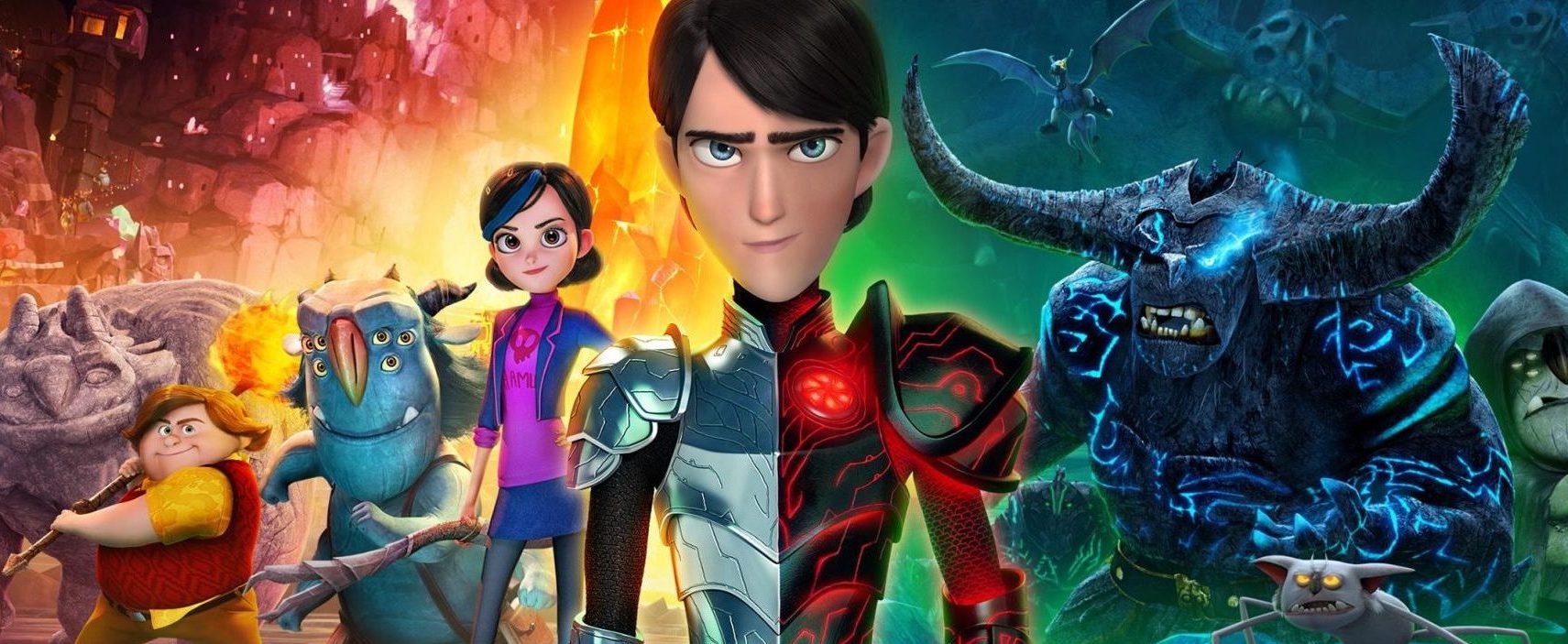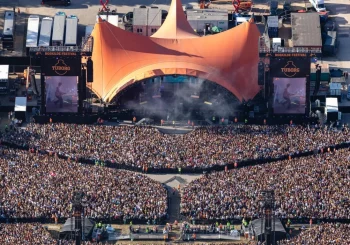Minor to major spoilers ahead for Trollhunters: Tales of Arcadia, Kung Fu Panda, How to Train Your Dragon, and Megamind.
“Master Jim, if I may, destiny is a gift. Some go their entire lives living existences of quiet desperation, never learning the truth: that what feels as though a burden pushing down upon our shoulders is actually the sense of purpose that lifts us to greater heights. Never forget that fear is but the precursor to valor, and to strive and triumph in the face of fear is what it means to be a hero. Don’t think, Master Jim. Become.”
Thus spoke Blinkous Galadrigal, or Blinky, a six-eyed, four-armed blue troll historian, to James Lake Jr.—the Trollhunter.
Trollhunters: Tales of Arcadia is an animated series about highschoolers Jim, Toby, and Claire discovering the secret troll world, with Jim, who seeks “something more” to life, chosen by a magical amulet to become the first ever human Trollhunter—protector of the good trolls from the evil ones.
The series does not, however, paint things so black and white. With many trolls, changelings—troll-human hybrids called “impures” by trolls—and humans changing allegiance, things are not always as they seem. Trollhunters: Tales of Arcadia is a coming of age story and a tale of how the mantle of responsibility is often thrust upon us. It is also about honor, empathy, humanity, and love.
Though the show can be at times—understandably—a little too child-oriented for my taste, it is, in general, not only entertaining, but also inspiring. Seeing young James Lake Jr. grow into the shoes of trollhunter and battle the forces of evil makes me want to grow as a person and seek value in my life.
I was not at all expecting the show to be this good. Dreamworks, however, rarely disappoints. I am quite partial towards the studio’s work—from Shrek to Kung fu Panda and from How to Train Your Dragon to Megamind, among others. While old Disney movies have shaped much of my childhood, I won’t discuss them as those are not the movies I watch today.
And while I don’t watch anime—largely for fear of getting addicted to it—I have an affinity to animated movies and series in general, for several reasons, and despite the flaws of Hollywood-made animation.
US-Centered Media
As a child, I watched Spacetoon and MBC3, and enjoyed traditional shows like Bakkar and Boogi wi Tamtam, while, granted, also watching Cartoon Network or Nickelodeon. Watching animated movies as an adult is a different experience, but I have lost a certain sense of familiarity through watching everything animated exclusively in English.
Moreover, there are certain settings, like a US suburb, which I just can’t relate to. Certain cultural norms like a large degree of independence provided to children or teens at a young age is also foreign to me as a viewer. But even when other cultures and places are used, it is almost always European, Far East Asian, or Latin American. I’m interested and keen to explore and learn more about the latter two regions, but watching an animated movie set in the Middle East and accurately portraying the local culture of the country it is set in would be a breath of fresh air.
I know there is a movie called Bilal: A New Breed of Hero about Prophet Muhammad’s companion, Bilal. However, I have yet to watch it, though I’m looking forward to doing so. That is the only 3D animated movie I can recall that is set in the Middle East. I hope that BIlal: A New Breed of Hero serves as a launchpad for more movies set in—and, hopefully, produced by—the region.
Why Animation?
Though there is a notable US focus in Hollywood-produced animation, there are also many compelling reasons to watch it.
First of all, animated movies speak to my inner child, which is something all adults need at times. In this ultracapitalist world and conservative society, that does not come so easily. So to have an outlet in which I can recapture those timeless moments of inexhaustible wonder feeds my soul and puts me in touch with my innermost self—the core in which this shell of adulthood strives to protect and preserve.
When I watch Po from Kung Fu Panda take on tens of enemies at once, or train to face the vicious Tai Lung, or travel with the Furious Five to Gongmen City to battle the devious Lord Shen, I can’t help but feel the giddy eagerness of my five year-old self wielding a plastic sword and sparring with imaginary enemies.
Kung Fu Panda in particular holds a special place in my heart. The first movie came out when I was young, maybe eight or nine years old, and I saw it in theaters when it first came out. It stuck with me because it was probably the first animated movie I watched in the cinema at a time when I didn’t go to the movies very often—and it was just so good. So when I found out, 10 years later, that there was a second and third movie, I was blown away.
At the time, I was studying in France and watching a fair amount of movies—usually coupled with pizza—in my free time. Somehow, the fact that a sequel and even a third movie were already out had completely slipped under my radar. So, as any fan of a movie has done at some point, I googled “Kung Fu Panda 2.”
My delight at finding two movies already out was only overshadowed by the feeling of epicness, fulfillment, and joy I felt that very night after watching Kung Fu Panda 2—which is my favorite of the franchise. It explores themes of identity, loss, and inner-peace, with the central question to the movie being “who am I?”
The villain, Lord Shen, constantly exploits Po’s desire to know more about his parents—who Shen supposedly had killed as part of a massacre of Panda village—to disorient Po. As it’s the darkest of the franchise with darker themes and a more sinister villain, I don’t watch it just any time.
This is another aspect of animation which draws me in: the balance between a light-hearted nature and an exploration of meaningful themes. While different movies and series oscillate between different balances, both elements are almost always present.
Sometimes, particularly when life gets tough, dry, or confusing, I just need to watch something fun and inspiring to break the cycle. When I’m down, I rarely feel the desire to watch live-action movies, and even then it would be something that feeds into my need for escapism like the Lord of the Rings or Harry Potter. At the same time, however, watching something silly would only make me feel worse, which is why the interweaving of valuable themes within is essential. I want to be inspired. I want to look to the vast world outside my window and say “hello world, are you ready for me?”
Though animation may seem childish or silly to some, it is a harbor for many. The widespread popularity of anime is contributing to breaking social stigmas that may exist when it comes to watching animated movies or series. Having Hollywood-made movies with themes that resound with older populations is helping do the same.
I have not personally encountered dismissal for gravitating towards animated media. Though, frankly, I don’t care enough to notice. It seems, however, that animated movies and series are generally well-received by those around me, as well as from what I read online. Doubtless, however, there are those who look down upon fans of animation as being stuck in their childhood ‘cartoon watching’ phase, but I am glad I have not met them.
Animation Added-Value
I like to believe that parts of the fantastical of animated movies do belong in reality—that entire societies can be convinced to radically change their ways, like in How to Train Your Dragon, or that true love really does not care about how a person looks, like in Shrek and Megamind.
Megamind in particular is one of my favorite movies of all time. Not only is it incredibly funny, but it also perfectly encapsulates the villain-turned-hero arc, and is, in my opinion, a romance as much as it is about heroes and villains. Moreover, romance in animated movies is not sexualized, as is often the case in live-action, which is an added bonus as it focuses on the emotional aspects of relationships.
Blue-skinned genius Megamind and Supermanesque Metroman are life-long nemeses with a certain charming chemistry between them. It seems Metroman is destined to be a hero, and Megamind a villain. Yet, Metroman, realizing that he has a choice, opts to fake his death to live a normal, non-superhero life. Megamind, in need of a hero to battle, tries to create one, but accidently imbues Metroman’s power in Hal, an archetypal incel.
When Hal is rejected by Roxanne Richie, his coworker and the heroine of the story, he turns into an all-out villain. Megamind, inspired by his own, reciprocated love for Roxanne took up the mantle of hero. He changes his ways as Roxanne brings out the best in him that was already there. It is an illustration of how love should raise people to new heights rather than set them in their toxic ways.
At the end of the movie, when all is said and done, Megamind says “funny, I guess destiny isn’t the path chosen for us, but the path we chose for ourselves.” To me, Megamind represents the power of self-definition, no matter the path one is initially cast upon.
Every animated movie teaches a lesson through its central theme. To me, being told that everyone can be a hero, like in Spiderman: Into the Spiderverse or Rango, makes it that much more fulfilling. Kung Fu Panda is all about accepting and believing in oneself while being just as entertaining, if not much more, than the vast majority of live-action movies.
And while many other non-animated movies and series also teach these lessons, the message is often stronger in animation, in part because that is expected of movies directed towards a younger audience, and in part because most modern live-action films are made largely for entertainment purposes.
This is the added value that is missing from many Hollywood flicks. Of course, this is my opinion as well as a generalization, but it is to say that animated movies and series provide a little something extra that is worth much to more than just children or teens.
Nevertheless, it is not like Hollywood-made animations are without flaws. For one, some movies, like The Soccer Football Movie are downright terrible. Others have less of a valuable message and are made for entertainment most of all. But even the really good movies that have come out of Hollywood have, as discussed, a sense of cultural whiplash for a viewer in the Middle East. Such movies are very Western and US-centric, and even when they’re set in different places and times and illustrate different cultures, the dialogue very often falls back on modern Americanisms.
Despite these flaws, animated movies and series are my go-to much of the time. There is something about the appropriately fantastical that makes a person feel like they can do anything.
There is also something about seeing heroics, often as part of a coming-of-age story delving into questions of identity, family, or responsibility, that make me want to be a hero in real life—which does not necessitate battling monsters or going on an over-the-top adventure, but rather never shying away from the honest path or shirking responsibility, taking care of the little things that matter, and being kind, compassionate, and optimistic.
Animated movies teach us that we can all be heroes in our own way.
The opinions and ideas expressed in this article are the author’s and do not necessarily reflect the views of Egyptian Streets’ editorial team. To submit an opinion article, please email [email protected].
Subscribe to the Egyptian Streets’ weekly newsletter! Catch up on the latest news, arts & culture headlines, exclusive features and more stories that matter, delivered straight to your inbox by clicking here.






Comment (1)
[…] Source link […]